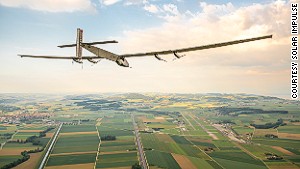This is pretty much it: the most dangerous part of a historic solar-powered adventure playing out thousands of feet above the Earth.
For folks who haven’t been following the around-the-world flight of the experimental Solar Impulse 2 since it began last March, this is probably the part where you’ll want to start paying attention.
Because what’s going on now is simply amazing.
After weeks of weather delays, a lone pilot named Andre Borschberg is now strapped into a tiny cockpit while flying a fragile plane more than 5,000 miles (8,000 kilometers) from Japan to Hawaii. The journey is expected to last about five days and nights.
If he succeeds, Borschberg — and his partner Bertrand Piccard, who’s been sharing flying duties along the route — will be the first aviators in history to fly a plane around the world without using a drop of fuel.

In the history of around-the-world flights, the Pacific has presented pitfalls for aviation pioneers — most infamously Amelia Earhart, who went missing in the central Pacific in July of 1937.
The solar plane’s mission reminds us that there are still many exploration challenges to conquer, even in the 21st century.
Soaring high above the water, Borschberg now faces hazards that could cripple his plane or even send it into the ocean, including turbulent winds and bad weather; mechanical malfunctions; and the pilot’s ability to remain alert and fly the plane.
Wanna follow the mission every step of the way? The official website offers a live video feed from the cockpit.
Here are six questions and answers from the Solar Impulse website explaining worst-case scenarios during the flight.
1. What if Borschberg has to bail out over the ocean?
“In the event of an emergency jump over an ocean, the pilot has a parachute and an inflatable life raft, which he can activate at any time. Built into the back of the pilot’s seat is a survival kit consisting of a parachute and life raft for use in case of emergency. Once in the sea, he must wait aboard the life raft until help arrives, which might take several days, the time needed to send a ship to his location. In preparation for this eventuality, the pilots received pre-flight training from specialists in sea rescue.”
2. What if the plane’s engines fail?
“If one of the 4 motors breaks down for example, the plane would operate with the other 3 remaining motors. The battery supplying the faulty motor would then be used for the adjacent motor. Most of the systems on board the plane are duplicated. If one were to fail, another would take over.”
3. What if the plane runs into dangerous turbulence?
“If the plane encounters turbulences stronger than the aircraft can handle, or is struck by lightning and runs into a thunderstorm, it would be destroyed. Therefore, it is important for the Solar Impulse expert meteorologists to forecast the weather conditions. Thanks to radar and satellite weather images, the team is able to detect these challenges.”
4. What if the aircraft crosses the path of other planes?
“Air traffic controllers monitor their radar screens and ensure that aircraft do not come too close to each other. Turbulence created by large aircrafts are dangerous for Solar Impulse. The airplane is fitted with a transponder, which transmits a signal allowing it to be identified on radar screens.”
5. What if the batteries don’t have enough stored solar energy when the sun goes down?
“Without enough energy in the batteries a night flight is impossible. The plane would have to make an emergency landing. That would be possible if it is flying over land, but if it is over the sea, the pilot could be electrocuted when the plane enters the water. The pilot would be obliged to bail out.”
6. How can the pilot rest during the long flight, without jeopardizing the mission?
The pilots have developed “stretching exercises to prevent thrombosis” that “increase blood circulation in vital organs and keep the pilot alert and concentrated on flying the airplane.”
“Above the ocean, sleep will be allowed in the form of short naps lasting up to 20 minutes, 10-12 times a day.” Piccard, who’s also a psychiatrist, “trained himself to only sleep for short periods by means of self-hypnosis — a technique used to dissociate the head from the body.” It “allows the body to regenerate into a very deep relaxation and keep the brain alert enough to check the instruments during the flight.
“The plane is equipped with an electronic system called a Stability Augmentation System that stabilizes the plane’s flight path and alerts the pilot in his sleep if there is a problem. Cloth armbands placed over the pilot’s arms are connected to an instrument developed by Omega that displays the bank angle of the plane. As soon as the bank angle goes beyond 5°, the armbands start to vibrate and an audible alarm wakes the pilot.”
As reported by CNN
